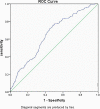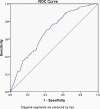An Endometrial Thickness < 8 mm Was Associated With a Significantly Increased Risk of EP After Freeze-Thaw Transfer: An Analysis of 5,960 Pregnancy Cycles
- PMID: 35813636
- PMCID: PMC9261458
- DOI: 10.3389/fendo.2022.884553
An Endometrial Thickness < 8 mm Was Associated With a Significantly Increased Risk of EP After Freeze-Thaw Transfer: An Analysis of 5,960 Pregnancy Cycles
Abstract
Introduction: Endometrium characteristics that are most likely to induce ectopic pregnancy were investigated on the basis of the data of 5,960 pregnant freeze-thaw cycles.
Methods: A total of 5,960 pregnancy cycles after freeze-thaw embryos transfer were included, with the number of intrauterine and ectopic pregnancies being 5,777 and 183, respectively. Ectopic pregnancy was the primary outcome. Endometrial thickness was the main measured variable. The risk factors of ectopic pregnancy were eventually determined based on univariate analysis and subsequent multiple-stepwise logistic regression analysis.
Results: 1. After adjusting for confounders, endometrial thickness could independently predict ectopic pregnancy. The adjusted odd ratios for women with endometrial thickness in the ranges of < 8 mm, 8-9.9 mm, and 10-11.9 mm were 3.270 [95% confidence interval (CI), 1.113-9.605, P = 0.031], 2.758 (95% CI, 0.987-7.707, P = 0.053), and 1.456 (95% CI, 0.502-4.225, P = 0.489), respectively, when compared with those having an endometrial thickness of 12-13.9 mm. 2. Endometrial type and preparation protocol were however not identified as risk factors for ectopic pregnancy.
Discussion: 1. After freeze-thaw embryo transfer, risks of ectopic pregnancy were significantly higher when the endometrial thickness was < 8 mm. 2. A thin endometrial thickness could be linked with abnormal endometrial peristaltic waves or abnormal endometrial receptivity. 3. Adequate attention should therefore be paid to patients with a thin endometrial thickness to prevent EP or to achieve early diagnosis during the peri-transplantation period.
Keywords: EMT; blastocyst; cleavage stage embryo; ectopic pregnancy; endometrial type; freeze-thaw cycles.
Copyright © 2022 Zhao, Liu, Liu, Li, Yao, Tian, Xu and Li.
Conflict of interest statement
The authors declare that the research was conducted in the absence of any commercial or financial relationships that could be construed as a potential conflict of interest.
Figures



Similar articles
-
An endometrium of type C along with an endometrial thickness of < 8 mm are risk factors for ectopic pregnancy after stimulated cycles with fresh embryo transfer.BMC Pregnancy Childbirth. 2023 Oct 6;23(1):713. doi: 10.1186/s12884-023-05920-y. BMC Pregnancy Childbirth. 2023. PMID: 37803277 Free PMC article.
-
Effect of endometrial thickness on ectopic pregnancy in frozen embryo transfer cycles: an analysis including 17,244 pregnancy cycles.Fertil Steril. 2020 Jan;113(1):131-139. doi: 10.1016/j.fertnstert.2019.09.003. Epub 2019 Nov 11. Fertil Steril. 2020. PMID: 31727414
-
Endometrial compaction after human chorionic gonadotrophin administration reduces ectopic pregnancy rate following fresh embryo transfer in vitro fertilization/intracytoplasmic sperm injection cycles in patients with non-thin endometrium: a retrospective cohort study.Reprod Biol Endocrinol. 2022 Oct 21;20(1):151. doi: 10.1186/s12958-022-01020-2. Reprod Biol Endocrinol. 2022. PMID: 36271375 Free PMC article.
-
Establishment of a prediction model for the impact of endometrial thickness on the day of embryo transfer on ectopic pregnancy in frozen-thawed embryo transfer cycle.Front Endocrinol (Lausanne). 2023 Nov 6;14:1259608. doi: 10.3389/fendo.2023.1259608. eCollection 2023. Front Endocrinol (Lausanne). 2023. PMID: 38027161 Free PMC article.
-
Frozen blastocyst transfer reduces incidence of ectopic pregnancy compared with fresh blastocyst transfer: a meta-analysis.Gynecol Endocrinol. 2019 Feb;35(2):93-99. doi: 10.1080/09513590.2018.1497154. Epub 2018 Aug 21. Gynecol Endocrinol. 2019. PMID: 30129787 Review.
Cited by
-
Young obese patients may benefit from GnRH-a long protocol contributing to higher implantation rate and live birth rate of fresh IVF-ET cycles.Heliyon. 2023 Sep 20;9(10):e20016. doi: 10.1016/j.heliyon.2023.e20016. eCollection 2023 Oct. Heliyon. 2023. PMID: 37810820 Free PMC article.
-
Decreased NSD2 impairs stromal cell proliferation in human endometrium via reprogramming H3K36me2.Reproduction. 2024 Feb 12;167(3):e230254. doi: 10.1530/REP-23-0254. Print 2024 Mar 1. Reproduction. 2024. PMID: 38236723 Free PMC article.
-
Precision Medicine for Chronic Endometritis: Computer-Aided Diagnosis Using Deep Learning Model.Diagnostics (Basel). 2023 Mar 1;13(5):936. doi: 10.3390/diagnostics13050936. Diagnostics (Basel). 2023. PMID: 36900079 Free PMC article. Review.
-
The thicker the endometrium, the better the neonatal outcomes?Hum Reprod Open. 2023 Jul 13;2023(3):hoad028. doi: 10.1093/hropen/hoad028. eCollection 2023. Hum Reprod Open. 2023. PMID: 37489142 Free PMC article.
-
Endometrial thickness and early pregnancy complications after frozen-thawed embryo transfers.Front Endocrinol (Lausanne). 2023 Aug 21;14:1066922. doi: 10.3389/fendo.2023.1066922. eCollection 2023. Front Endocrinol (Lausanne). 2023. PMID: 37670886 Free PMC article.
References
-
- Muller V, Makhmadalieva M, Kogan I, Fedorova I, Lesik E, Komarova E, et al. . Ectopic Pregnancy Following In Vitro Fertilization: Meta-Analysis and Single-Center Experience During 6 Years. Gynecol Endocrinol Off J Int Soc Gynecol Endocrinol (2016) 32:69–74. doi: 10.1080/09513590.2016.1232550 - DOI - PubMed

